key INFINITI QX80 2021 Owner's Manual
[x] Cancel search | Manufacturer: INFINITI, Model Year: 2021, Model line: QX80, Model: INFINITI QX80 2021Pages: 529, PDF Size: 2.05 MB
Page 4 of 529
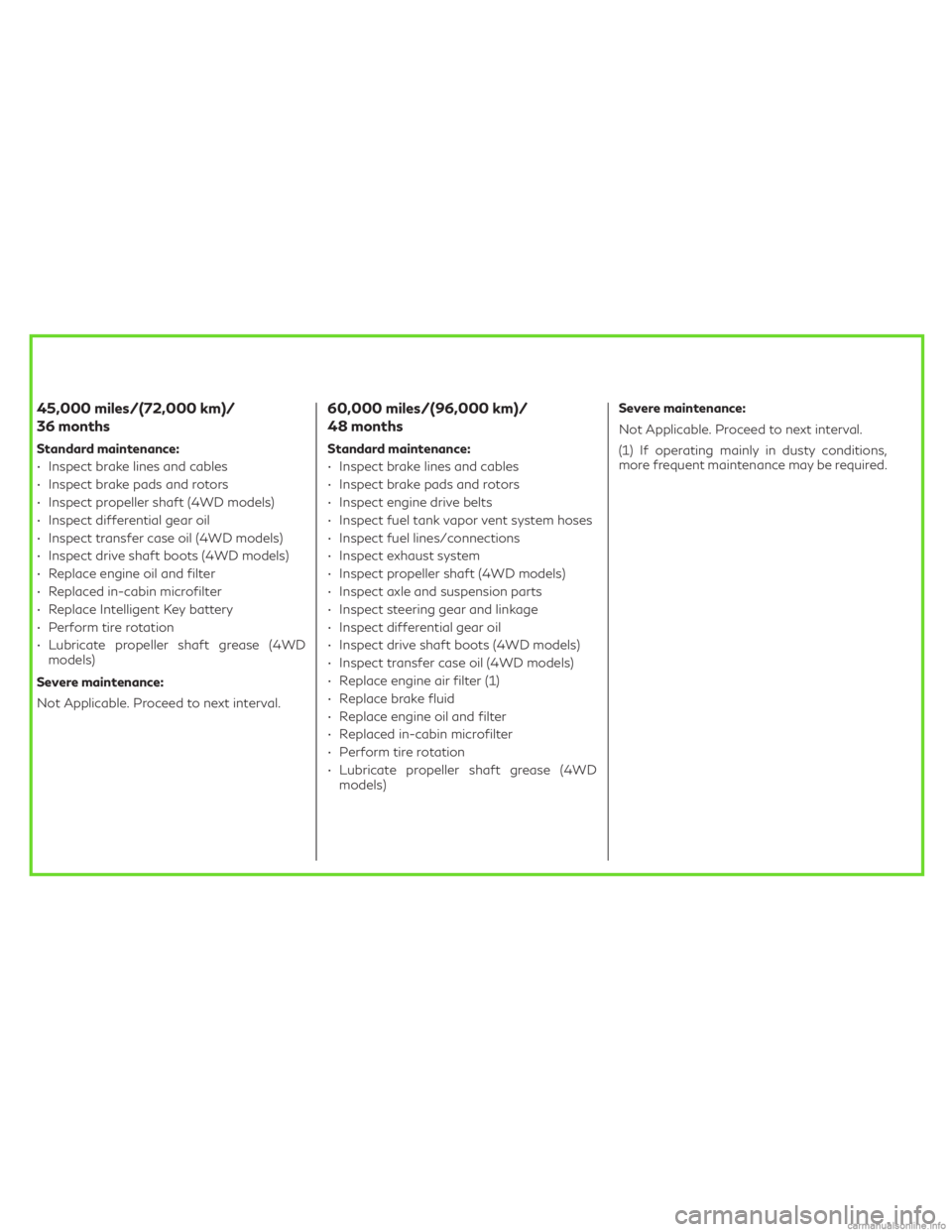
45,000 miles/(72,000 km)/
36 months
Standard maintenance:
• Inspect brake lines and cables
• Inspect brake pads and rotors
• Inspect propeller shaft (4WD models)
• Inspect differential gear oil
• Inspect transfer case oil (4WD models)
• Inspect drive shaft boots (4WD models)
• Replace engine oil and filter
• Replaced in-cabin microfilter
• Replace Intelligent Key battery
• Perform tire rotation
• Lubricate propeller shaft grease (4WD
models)
Severe maintenance:
Not Applicable. Proceed to next interval.
60,000 miles/(96,000 km)/
48 months
Standard maintenance:
• Inspect brake lines and cables
• Inspect brake pads and rotors
• Inspect engine drive belts
• Inspect fuel tank vapor vent system hoses
• Inspect fuel lines/connections
• Inspect exhaust system
• Inspect propeller shaft (4WD models)
• Inspect axle and suspension parts
• Inspect steering gear and linkage
• Inspect differential gear oil
• Inspect drive shaft boots (4WD models)
• Inspect transfer case oil (4WD models)
• Replace engine air filter (1)
• Replace brake fluid
• Replace engine oil and filter
• Replaced in-cabin microfilter
• Perform tire rotation
• Lubricate propeller shaft grease (4WD
models)Severe maintenance:
Not Applicable. Proceed to next interval.
(1) If operating mainly in dusty conditions,
more frequent maintenance may be required.
Page 5 of 529
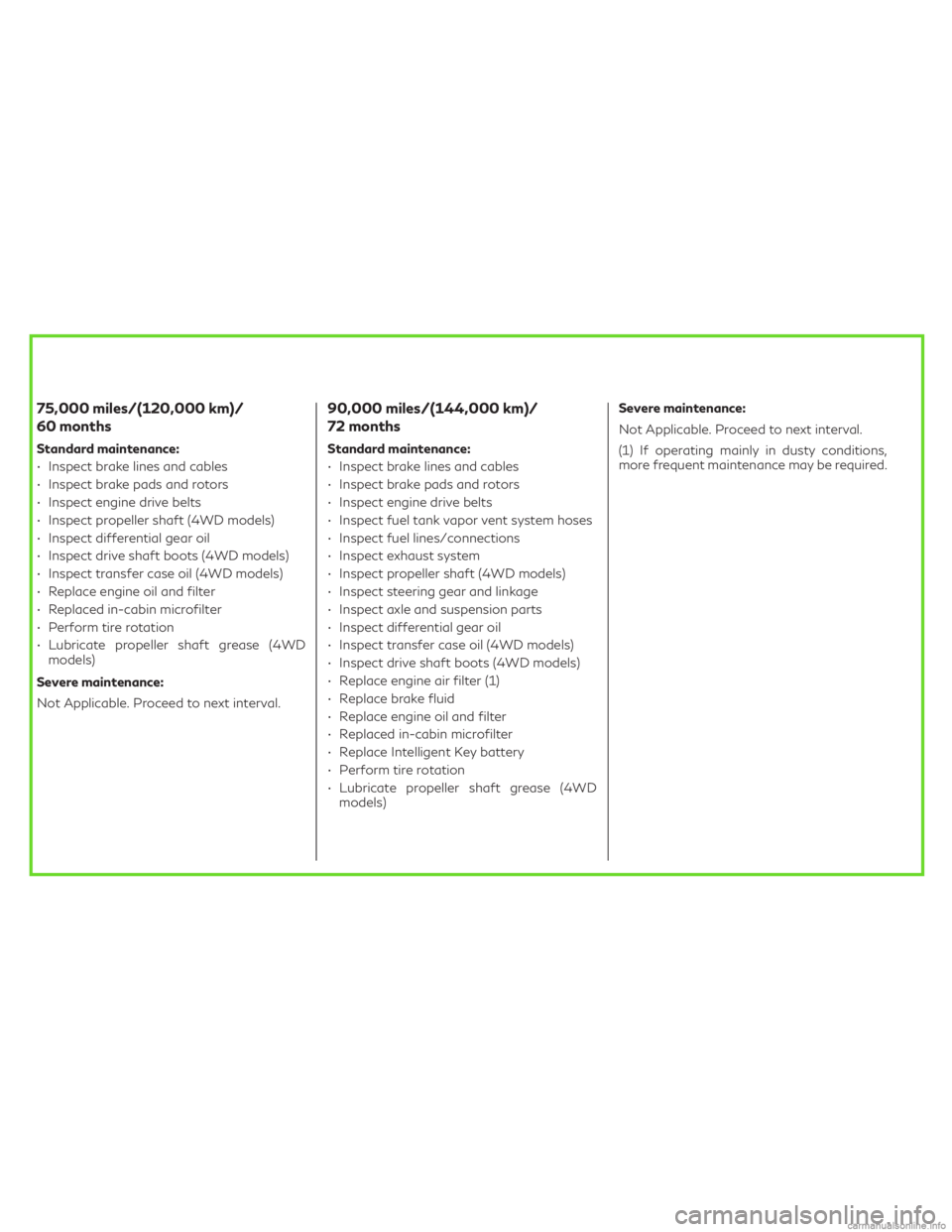
75,000 miles/(120,000 km)/
60 months
Standard maintenance:
• Inspect brake lines and cables
• Inspect brake pads and rotors
• Inspect engine drive belts
• Inspect propeller shaft (4WD models)
• Inspect differential gear oil
• Inspect drive shaft boots (4WD models)
• Inspect transfer case oil (4WD models)
• Replace engine oil and filter
• Replaced in-cabin microfilter
• Perform tire rotation
• Lubricate propeller shaft grease (4WD
models)
Severe maintenance:
Not Applicable. Proceed to next interval.
90,000 miles/(144,000 km)/
72 months
Standard maintenance:
• Inspect brake lines and cables
• Inspect brake pads and rotors
• Inspect engine drive belts
• Inspect fuel tank vapor vent system hoses
• Inspect fuel lines/connections
• Inspect exhaust system
• Inspect propeller shaft (4WD models)
• Inspect steering gear and linkage
• Inspect axle and suspension parts
• Inspect differential gear oil
• Inspect transfer case oil (4WD models)
• Inspect drive shaft boots (4WD models)
• Replace engine air filter (1)
• Replace brake fluid
• Replace engine oil and filter
• Replaced in-cabin microfilter
• Replace Intelligent Key battery
• Perform tire rotation
• Lubricate propeller shaft grease (4WD
models)Severe maintenance:
Not Applicable. Proceed to next interval.
(1) If operating mainly in dusty conditions,
more frequent maintenance may be required.
Page 16 of 529

JVC1126X
1. Hood (P.3-21)
2. Windshield wiper and washer— Switch operation (P.2-36)
— Rain-sensing auto wiper system
(P.2-38)
— Wiper blade replacement (P.8-15) — Window washer fluid (P.8-10)
3. Moonroof (P.2-70)
4. Power windows (P.2-68)
5. Roof rack (P.2-67)
6. Towing hook (P.6-18)
7. Front view camera (P.4-3) 8. Sensors
— Camera aiding sonar function
(P.4-17)
9. Headlight washers (if so equipped) (P.2-45)
10. Fog light (P.2-47)
11. Headlight (P.2-40) — Adaptive Front lighting System
(AFS) (if so equipped) (P.2-45)
12. Front parking light/daytime running light/front turn signal light (P.2-40)
13. Tires — Wheel and tires (P.8-27, P.10-9)
— Flat tire (P.6-3)
— Tire Pressure Monitoring System
(TPMS) (P.2-16, P.5-5)
14. Outside mirrors (P.3-37) — Side view camera (P.4-3)
— Welcome light (P.2-72)
15. Side turn signal lights (P.8-23)
16. Doors — Keys (P.3-2)
— Door locks (P.3-4)
— Intelligent Key system (P.3-7)
— Remote keyless entry system
(P.3-15)
— Remote engine start (if so equipped)
(P.3-19)
Illustrated table of contents0-3
EXTERIOR FRONT
Page 18 of 529

JVC1127X
1. Fuel-filler door (P.3-26)— Fuel information (P.10-4)
2. Antenna (P.4-37)
3. Rear combination light (P.8-23)
4. Rear window defroster (P.2-39)
5. Satellite antenna (P.4-38) 6. Smart Rearview Mirror camera (if so
equipped) (P.3-31)
7. High-mounted stop light (P.8-23)
8. Liftgate (P.3-22) — Intelligent Key system (P.3-7) 9. Rear window wiper and washer
— Switch operation (P.2-39)
— Window washer fluid (P.8-10)
10. Spare tire (under the vehicle) (P.6-3)
11. Rear turn signal light — Switch operation (P.2-46)
12. Towing hook (P.6-18)
13. Sensors — Camera aiding sonar function
(P.4-17)
14. Rear view camera (P.4-3)
15. Trailer hitch (P.10-23)
Illustrated table of contents0-5
EXTERIOR REAR
Page 49 of 529
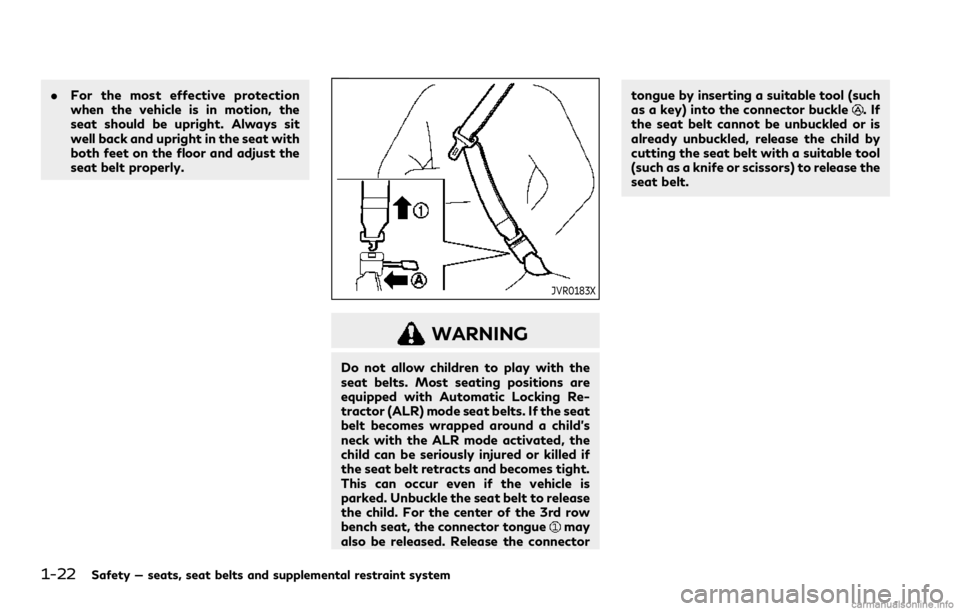
1-22Safety — seats, seat belts and supplemental restraint system
.For the most effective protection
when the vehicle is in motion, the
seat should be upright. Always sit
well back and upright in the seat with
both feet on the floor and adjust the
seat belt properly.
JVR0183X
WARNING
Do not allow children to play with the
seat belts. Most seating positions are
equipped with Automatic Locking Re-
tractor (ALR) mode seat belts. If the seat
belt becomes wrapped around a child’s
neck with the ALR mode activated, the
child can be seriously injured or killed if
the seat belt retracts and becomes tight.
This can occur even if the vehicle is
parked. Unbuckle the seat belt to release
the child. For the center of the 3rd row
bench seat, the connector tongue
may
also be released. Release the connector tongue by inserting a suitable tool (such
as a key) into the connector buckle
.If
the seat belt cannot be unbuckled or is
already unbuckled, release the child by
cutting the seat belt with a suitable tool
(such as a knife or scissors) to release the
seat belt.
Page 53 of 529
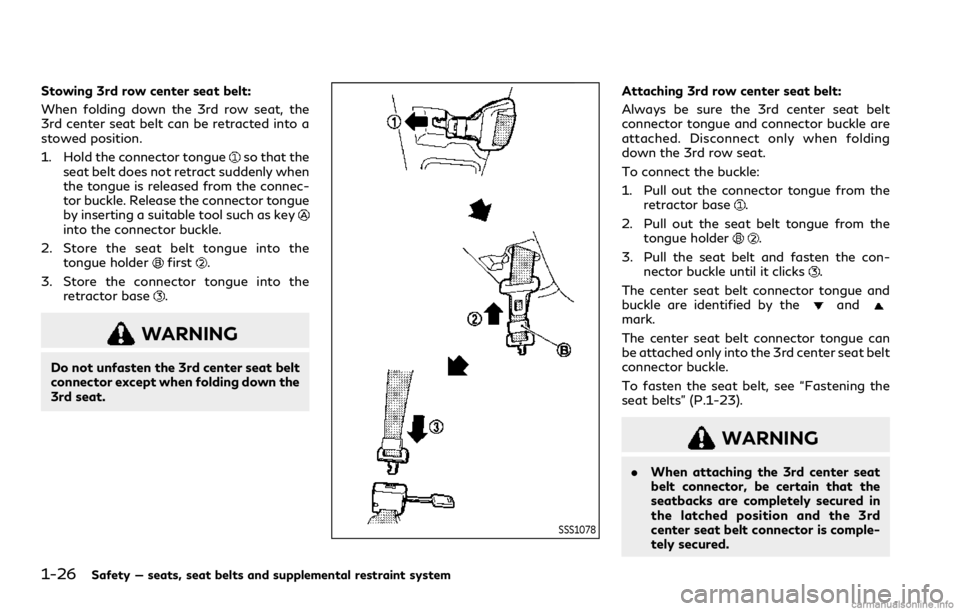
1-26Safety — seats, seat belts and supplemental restraint system
Stowing 3rd row center seat belt:
When folding down the 3rd row seat, the
3rd center seat belt can be retracted into a
stowed position.
1. Hold the connector tongue
so that the
seat belt does not retract suddenly when
the tongue is released from the connec-
tor buckle. Release the connector tongue
by inserting a suitable tool such as key
into the connector buckle.
2. Store the seat belt tongue into the tongue holder
first.
3. Store the connector tongue into the retractor base
.
WARNING
Do not unfasten the 3rd center seat belt
connector except when folding down the
3rd seat.
SSS1078
Attaching 3rd row center seat belt:
Always be sure the 3rd center seat belt
connector tongue and connector buckle are
attached. Disconnect only when folding
down the 3rd row seat.
To connect the buckle:
1. Pull out the connector tongue from theretractor base
.
2. Pull out the seat belt tongue from the tongue holder
.
3. Pull the seat belt and fasten the con- nector buckle until it clicks
.
The center seat belt connector tongue and
buckle are identified by the
andmark.
The center seat belt connector tongue can
be attached only into the 3rd center seat belt
connector buckle.
To fasten the seat belt, see “Fastening the
seat belts” (P.1-23).
WARNING
. When attaching the 3rd center seat
belt connector, be certain that the
seatbacks are completely secured in
the latched position and the 3rd
center seat belt connector is comple-
tely secured.
Page 56 of 529
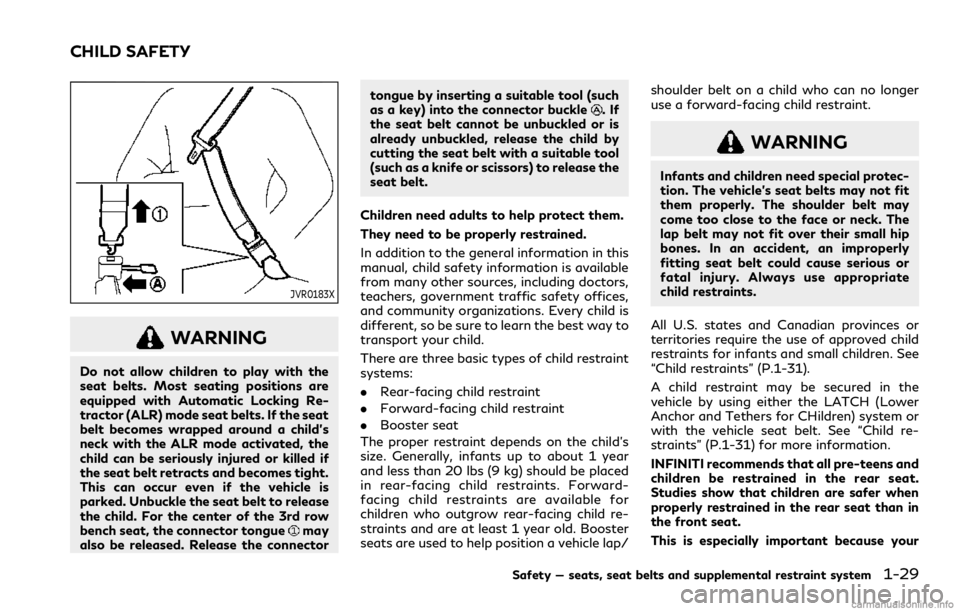
JVR0183X
WARNING
Do not allow children to play with the
seat belts. Most seating positions are
equipped with Automatic Locking Re-
tractor (ALR) mode seat belts. If the seat
belt becomes wrapped around a child’s
neck with the ALR mode activated, the
child can be seriously injured or killed if
the seat belt retracts and becomes tight.
This can occur even if the vehicle is
parked. Unbuckle the seat belt to release
the child. For the center of the 3rd row
bench seat, the connector tongue
may
also be released. Release the connector tongue by inserting a suitable tool (such
as a key) into the connector buckle
.If
the seat belt cannot be unbuckled or is
already unbuckled, release the child by
cutting the seat belt with a suitable tool
(such as a knife or scissors) to release the
seat belt.
Children need adults to help protect them.
They need to be properly restrained.
In addition to the general information in this
manual, child safety information is available
from many other sources, including doctors,
teachers, government traffic safety offices,
and community organizations. Every child is
different, so be sure to learn the best way to
transport your child.
There are three basic types of child restraint
systems:
. Rear-facing child restraint
. Forward-facing child restraint
. Booster seat
The proper restraint depends on the child’s
size. Generally, infants up to about 1 year
and less than 20 lbs (9 kg) should be placed
in rear-facing child restraints. Forward-
facing child restraints are available for
children who outgrow rear-facing child re-
straints and are at least 1 year old. Booster
seats are used to help position a vehicle lap/ shoulder belt on a child who can no longer
use a forward-facing child restraint.
WARNING
Infants and children need special protec-
tion. The vehicle’s seat belts may not fit
them properly. The shoulder belt may
come too close to the face or neck. The
lap belt may not fit over their small hip
bones. In an accident, an improperly
fitting seat belt could cause serious or
fatal injury. Always use appropriate
child restraints.
All U.S. states and Canadian provinces or
territories require the use of approved child
restraints for infants and small children. See
“Child restraints” (P.1-31).
A child restraint may be secured in the
vehicle by using either the LATCH (Lower
Anchor and Tethers for CHildren) system or
with the vehicle seat belt. See “Child re-
straints” (P.1-31) for more information.
INFINITI recommends that all pre-teens and
children be restrained in the rear seat.
Studies show that children are safer when
properly restrained in the rear seat than in
the front seat.
This is especially important because your
Safety — seats, seat belts and supplemental restraint system1-29
CHILD SAFETY
Page 116 of 529

WARNING/INDICATOR LIGHTS
(other)
See “Vehicle information display” (P.2-20).
Exterior light indicator
This indicator illuminates when the headlight
switch is turned to the AUTO,orposition and the front parking lights, instru-
ment panel lights, rear combination lights,
license plate lights or headlights are on. The
indicator turns off when these lights are
turned off.
Front fog light indicator light
The front fog light indicator light illuminates
when the front fog lights are on. (See “Fog
light switch” (P.2-47).)
Front passenger air bag status
light
The front passenger air bag status light
() located on the instrument panel will be
lit and the passenger front air bag will be
OFF depending on how the front passenger
seat is being used.
For front passenger air bag status light
operation, see “INFINITI Advanced Air Bag
System (front seats)” (P.1-58).
High beam assist indicator
light
The indicator light illuminates when the
headlights come on while the headlight
switch is in the AUTO position with the high
beam selected. This indicates that the high
beam assist system is operational. (See
“High beam assist” (P.2-41).)
High beam indicator light
This light comes on when the headlight high
beam is on and goes out when the low beam
is selected.
TOW mode indicator light
This light will illuminate when the TOW
mode is selected while the engine is running.
(See “TOW mode” (P.5-122).)
Turn signal/hazard indicator
lights
The light flashes when the turn signal switch
lever or hazard switch is turned on.
AUDIBLE REMINDERS
Key reminder chime
A chime will sound if the driver side door is
opened while the ignition switch is pushed to
the ACC position. Make sure the ignition
switch is pushed to the OFF position, and
take the Intelligent Key with you when
leaving the vehicle.
Light reminder chime
A chime will sound when the driver side door
is opened with the light switch in theorposition and the ignition switch in the
ACC, OFF or LOCK position.
Turn the light switch off when you leave the
vehicle.
Parking brake reminder chime
The chime will sound if the vehicle is driven
at more than 4 MPH (7 km/h) with the
parking brake applied. Stop the vehicle and
release the parking brake.
Brake pad wear warning
The disc brake pads have audible wear
warnings. When a brake pad requires repla-
cement, it will make a high pitched scraping
sound when the vehicle is in motion. This
scraping sound will first occur only when the
brake pedal is depressed. After more wear of
Instruments and controls2-19
Page 117 of 529

2-20Instruments and controls
the brake pad, the sound will always be
heard even if the brake pedal is not
depressed. Have the brakes checked as soon
as possible if the warning sound is heard.
JVI1272X
The vehicle information displayis located
between the tachometer and the speed-
ometer, and it displays the warnings and
information. The following items are also
displayed if the vehicle is equipped with
them:
. Odometer/twin trip odometer
— “Odometer/twin trip odometer” (P.2- 7)
. Automatic Transmission (AT)
— “Driving the vehicle” (P.5-17).
. Four-Wheel Drive (4WD) system
— “INFINITI all-mode 4WD
®” (P.5-113)
. Cruise control system
— “Cruise control” (P.5-62) .
Intelligent Cruise Control (ICC) system
— “Intelligent Cruise Control (ICC)” (P.5- 64)
. Distance Control Assist (DCA) system
— “Distance Control Assist (DCA)” (P.5- 84)
. Intelligent Key system
— “Intelligent Key system” (P.3-7)
— “Push-button ignition switch” (P.5- 12)
. Lane Departure Warning (LDW)/Lane
Departure Prevention (LDP)
— “Lane Departure Warning (LDW)/ Lane Departure Prevention (LDP)”
(P.5-22)
. Blind Spot Warning (BSW)
— “Blind Spot Warning (BSW)” (P.5-31)
. Blind Spot Intervention
®(BSI)
— “Blind Spot Intervention®(BSI)” (P.5-
41)
. Back-up Collision Intervention (BCI) sys-
tem
— “Back-up Collision Intervention (BCI)” (P.5-53)
. Forward Emergency Braking (FEB) with
pedestrian detection system
— “Forward Emergency Braking (FEB)
with pedestrian detection” (P.5-95)
. Predictive Forward Collision Warning
(PFCW) system
VEHICLE INFORMATION DISPLAY
Page 121 of 529

2-24Instruments and controls
OPERATIONAL INDICATORS
1. No Key Detected
This warning appears when the Intelligent
Key is left outside the vehicle with the
ignition switch in the ON position. Make
sure the Intelligent Key is inside the vehicle.
See “Intelligent Key system” (P.3-7) for more
details.
2. Key ID Incorrect
This warning appears when the ignition
switch is pushed from the OFF position
and the Intelligent Key is not recognized by
the system. You cannot start the engine with
an unregistered key.
See “Intelligent Key system” (P.3-7).
3. Key Battery Low
This indicator appears when the Intelligent
Key battery is running out of power.
If this indicator appears, replace the battery
with a new one. (See “Intelligent Key battery
replacement” (P.8-21).)
4. Key System Error: See Owner’s
Manual
This warning appears if there is a malfunc-
tion in the Intelligent Key system. If this
warning appears while the engine isstopped, it may be impossible to start the
engine.
If this warning appears while the engine is
running, you can drive the vehicle. However
in these cases, have the system checked. It is
recommended you visit an INFINITI retailer
for this service.
5. Key Registration Complete
This indicator appears when a new Intelli-
gent Key is registered to the vehicle.
6. Push brake and start switch to
drive
This indicator appears when the shift lever is
in the P (Park) position.
This indicator also appears when the vehicle
has been started using the Remote Engine
Start function (if so equipped).
This indicator means that the engine will
start by pushing the ignition switch with the
brake pedal depressed. You can start the
engine from any position of the ignition
switch.
7. Push Ignition to OFF
After the Shift to Park warning illuminates,
the warning will illuminate if the ignition
switch is placed in the ACC position when
the shift lever moves into the P (Park)
position.To turn off the warning, place the ignition
switch in the ON position and then in the
LOCK position.
8. Shift to Park
This warning appears when the ignition
switch is pushed to stop the engine with
the shift lever in any position except the P
(Park) position.
If this warning appears, move the shift lever
to the P (Park) position or push the ignition
switch to the ON position.
An inside warning chime will also sound. (See
“Intelligent Key system” (P.3-7).)
9. Engine start operation for Intel-
ligent Key system indicator (if I-Key
battery level is low)
This indicator appears when the Intelligent
Key battery is running out of power and
when the Intelligent Key system and vehicle
are not communicating normally.
If this indicator appears, touch the ignition
switch with the Intelligent Key while depres-
sing the brake pedal. (See “Intelligent Key
battery discharge” (P.5-14).)
10. Release Parking Brake
This warning appears when the vehicle
speed is above 4 MPH (7 km/h) and the